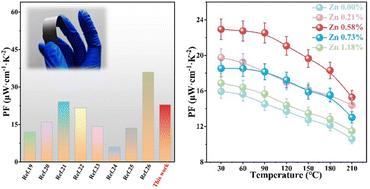A Zn-doped Sb2Te3 flexible thin film with decoupled Seebeck coefficient and electrical conductivity via band engineering
IF 7.6
1区 化学
Q1 CHEMISTRY, MULTIDISCIPLINARY
引用次数: 0
Abstract
Sb2Te3-based flexible thin films can be utilized in the fabrication of self-powered wearable devices due to their huge potential in thermoelectric performance. Although doping can significantly enhance the power factor value, the process of identifying suitable dopants is typically accompanied by numerous repeating experiments. Herein, we introduce Zn doping into thermally diffused p-type Sb2Te3 flexible thin films with a candidate dopant validated using the first-principles calculations. Subsequent experiments further corroborated the successful introduction of a Zn dopant and the improvement of thermoelectric performance. Specifically, p-type doping and the increase in the calculated effective mass can significantly increase the Seebeck coefficient, achieving the decoupling of the Seebeck coefficient and electrical conductivity in Sb2Te3 flexible thin films. An outstanding power factor of ∼22.93 μW cm−1 K−2 at room temperature can be obtained in the 0.58% Zn doped Sb2Te3 sample with significant flexibility. The subsequent fabrication of a flexible thermoelectric generator provides the maximum output voltage and output power of ∼53.0 mV and ∼1100 nW with a temperature difference of 40 K, respectively, pointing out the huge potential of Zn-doped Sb2Te3 materials for thermoelectric applications in self-powered wearable devices.

求助全文
约1分钟内获得全文
求助全文
来源期刊

Chemical Science
CHEMISTRY, MULTIDISCIPLINARY-
CiteScore
14.40
自引率
4.80%
发文量
1352
审稿时长
2.1 months
期刊介绍:
Chemical Science is a journal that encompasses various disciplines within the chemical sciences. Its scope includes publishing ground-breaking research with significant implications for its respective field, as well as appealing to a wider audience in related areas. To be considered for publication, articles must showcase innovative and original advances in their field of study and be presented in a manner that is understandable to scientists from diverse backgrounds. However, the journal generally does not publish highly specialized research.
 求助内容:
求助内容: 应助结果提醒方式:
应助结果提醒方式:


